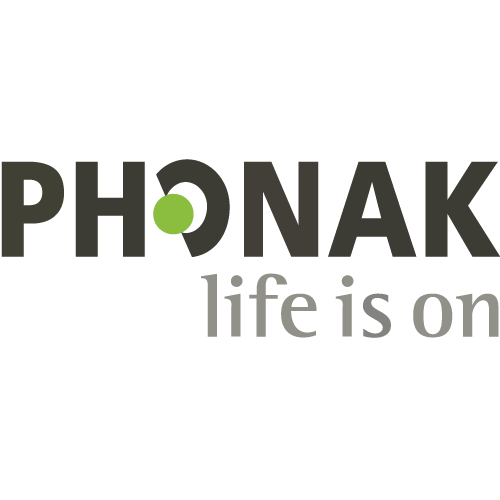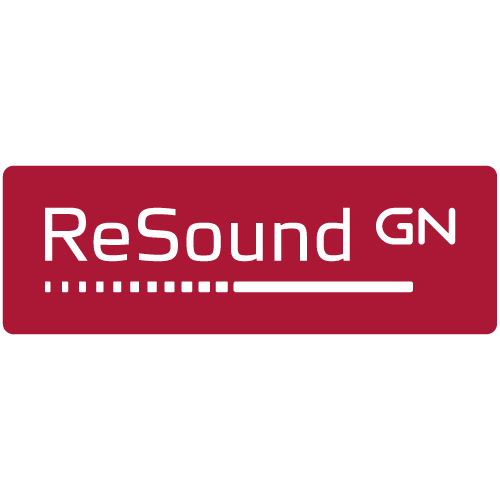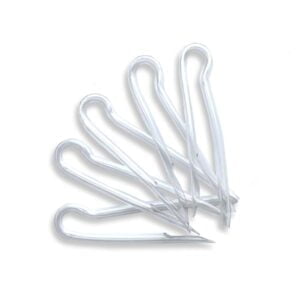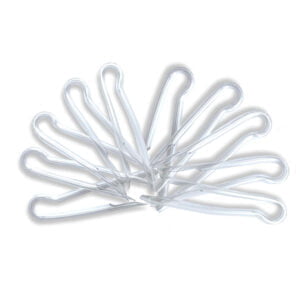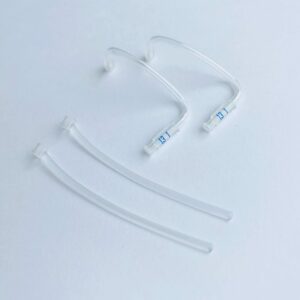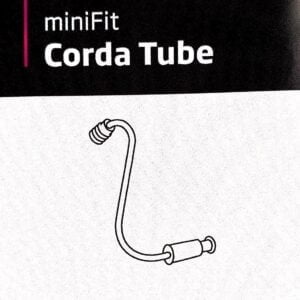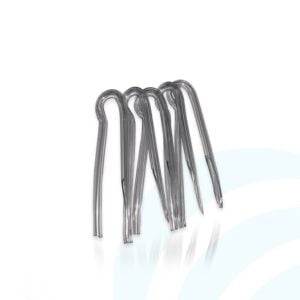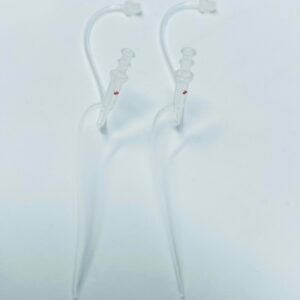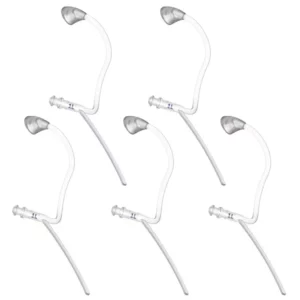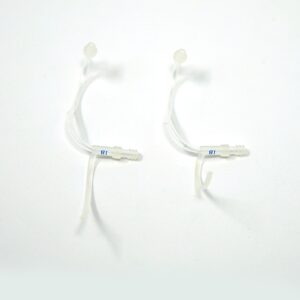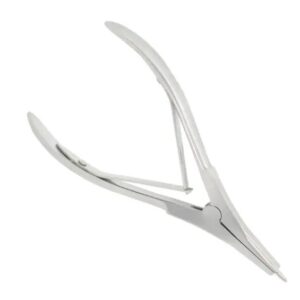Hearing Aid Tubes
Effective hearing aid tubes can be the difference between clear, solid sound and distorted, unintelligible sound. Hearing aid tubes often need replacing due to moisture, earwax build-up, and general wear. At Hearing Aid Accessories, we offer an extensive range of hearing aid tubes at great prices.
Shop by brand or browse our full selection
-
BTE Earmold Pre Bent Hearing Aid Tubes 5pcs – 10pcs
- $7.99 – $17.99Price range: $7.99 through $17.99
- Behind the ear (BTE) hearing aids that are worn with a molded earpiece require the tubing to be changed on a regular basis. It is recommended that you replace your tubing every three to six months. Hearing aid tubing comes in different sizes and types, so it is recommended to speak to your audiologist to ensure you buy the correct…
- Select options This product has multiple variants. The options may be chosen on the product page
-
Phonak Receiver Removal Tool
- $4.99
- Tool to help remove and insert the pins of your hearing aid housings and to operate the receiver locking mechanism. Includes: x1 Receiver Removal Tool
- Add to cart
-
Phonak Slim Tube HE – Tubes for Hearing Aids
- $13.99
- Phonak SlimTubes reduce visibility whilst being worn on the ear and include an attached retention lock. Brand: Phonak This product includes: x1 pack of 2 HE SlimTubes
- Select options This product has multiple variants. The options may be chosen on the product page
-
Oticon MiniFit Corda Thin Tube 1.3 – 2 pack
- $12.99
- Thin Tubes suitable for selected Oticon BTE and miniBTE aids. Available in different lengths to suit you. Brand : Oticon Includes : x2 thin tubes & retention locks
- Select options This product has multiple variants. The options may be chosen on the product page
-
SPECIAL OFFER: Pre-Bent Hearing Aid Tubes – 25 for $19.49
- $21.99
- It is surprising how much this tubing can improve the sound quality of your hearing aids - Get yours today! Our bulk offer is perfect for you to stock up. Behind-the-ear (BTE) hearing aids worn with a moulded earpiece require the tubing to be changed on a regular basis; it is highly recommended that you replace your tubing every three…
- Select options This product has multiple variants. The options may be chosen on the product page
-
Oticon MiniFit Corda Tube 0.9 (2 pack)
- $14.99 – $15.99Price range: $14.99 through $15.99
- Corda Tube suitable for Oticon Hearing Aids. Brand : Oticon Includes : x2 thin tubes Please note these tubes are ordered upon request. Please allow an additional 2-3 working days for your order to be dispatched.
- Select options This product has multiple variants. The options may be chosen on the product page
-
Signia Connexx Thin Tube (2 pack)
- $9.99
- Replacement thin tubes suitable for selected Signia Connexx hearing aids such as the NHS Contrast range, or Signia NX range. Each tube has an attached retention to help keep your thin tube in place during wear. Includes: x2 thin tubes with attached retentions & x1 cleaning wire stick
- Select options This product has multiple variants. The options may be chosen on the product page
-
Phonak 4.0 Slim Tubes for Phonak Marvel, Paradise and Lumity Hearing Aids – 5 Pack
- $24.99
- Phonak Slim Tube 4.0 hearing aid tubes fit Marvel, Paradise and Lumity hearing aids. This replacement pack of five slim tubes is for behind-the-ear hearing aid models that require SlimTube replacement. SlimTubes reduce visibility whilst being worn on the ear and include an attached retention lock. Brand: Phonak This product includes: 1 pack of 5 Phonak 4.0 SlimTubes and 2…
- Select options This product has multiple variants. The options may be chosen on the product page
-
GN Resound Danalogic Surefit Thin Tube (2 pack)
- $14.99
- As of January 2025, these Thin Tubes have been discontinued and replaced with Surefit 2C tubes. We still have limited stock available, however if your style and size is not available you will now need to use Surefit 2C tubes which are the direct replacement. Click here to be re-directed Thin tubes for selected GN ReSound and Danalogic hearing aids – to…
- Select options This product has multiple variants. The options may be chosen on the product page
-
Signia Life Tubes – Thin Tubes for Signia Contrast & Siemens Teneo Aids (2 pack)
- $9.49
- Signia Life Tubes (thin tubes) compatible with Signia Contrast, Siemens Teneo & Siemens Octiv hearing aids. Available in either Left or Right ear, & sizes 1-6. Each tube has an attached retention to help keep your thin tube in place during wear. Brand: Signia This product includes: x2 Signia Life Tubes & x1 cleaning wire stick Please note these tubes are ordered…
- Select options This product has multiple variants. The options may be chosen on the product page
-
Tubing Threader
- $9.99
- Easily rethread your earmoulds with new tubing using this handy earmould tube threader, featuring a large red handle for a secure grip.
- Add to cart
-
Tubing Expander for Hearing Aids
- $76.99
- Tubing Expander tool used to widen ear mould tubing for an easy fit onto the hearing aid elbow.
- Add to cart
FAQ
What is a hearing aid tube?
Hearing aid tubes serve a critical purpose by transmitting sound waves from the hearing aid microphone to the receiver, which then converts the sound back for you to hear. The tube must be maintained in good condition to ensure clear sound transmission.
When should I get a new hearing aid tube?
To check if your hearing aid tube needs replacing, gently squeeze it. If it quickly returns to its original shape, it’s fine. If it remains bent, it needs to be changed promptly to prevent your hearing from deteriorating.
How can I make my hearing aid tube fit me?
Hearing aid tubes can be customised to fit your specific needs:
- Length via roll of tubing: Bulk rolls allow you to cut the tubing to the desired length. This option is ideal for experienced users.
- Thickness: Pre-bent tubing of various thickness is available. Thicker tubing is usually required for more severe hearing loss. Consult your hearing aid dispenser to determine the appropriate thickness for you.
- Condensation Tubing: Designed to prevent moisture build-up, increasing the lifespan of your hearing aid and improving sound quality.
- Colour: Tubing is available in different colours to match your style or preference.
What tools will I need to replace hearing aid tubing?
If you decide to change the hearing aid tubing yourself, you will need the following tools:
- Cutters: To cut the tubing to the required length and clean up any mistakes.
- Pliers: To shape and guide the tubing into place and to deconstruct the hearing aid if needed.
- Tubing Extractor: To remove the earmold from the hearing aid, especially if it has degraded or the tube is larger than expected.
- Tubing Threader: To thread the tubing through the earmold easily. Some tools combine the threader and extractor.
Glue: To secure the new tubing if necessary. Ensure the glue is suitable for your hearing aids to avoid damage.
How do I change my hearing aid tube?
- Clean the new tubing, making sure there is no dust or debris inside it. Repeat the process with your hearing aid, including your old tubing. This will ensure no dirt will get into the mould once you take it out.
- Remove the old tubing from the hearing aid. It should come off easily unless glued. If glued, use a tubing extractor or consult your audiologist.
- Use scissors or pliers to peel the old tubing off the coupler until it can be gently pulled out.
- Use the old tube as a guide to measure and cut the new tubing to the desired length.
- Use the tubing threader to pull the new tubing through the earmold to the correct position.
- Ensure the tube is firmly in place. If it’s loose, use small drops of suitable glue to secure it.
If you are ever in doubt, consult your audiologist for assistance with your refit.

